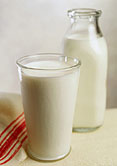- Skip Storing This Everyday Product in the Fridge Door
- Green Tea + B3 Pairing May Boost Brain Health
- Navigating Your Midlife Crisis: Embracing New Possibilities
- City Raccoons Showing Signs of Domestication
- Mapping the Exposome: Science Broadens Focus to Environmental Disease Triggers
- One Week Less on Social Media Linked to Better Mental Health
- Your Brain Changes in Stages as You Age, Study Finds
- Some Suicide Victims Show No Typical Warning Signs, Study Finds
- ByHeart Formula Faces Lawsuits After Babies Sickened With Botulism
- Switch to Vegan Diet Could Cut Your Greenhouse Gas Emissions in Half
Drinking Milk as Teens Might Not Protect Men’s Bones, Study Suggests


Boys who drink more milk during their teenage years might not see any drop in their risk for hip fractures as adults, new research suggests. Just the opposite: Their risk actually might rise.
The finding, which was not observed among women, is based on the fracture history of nearly 100,000 white men and women, middle-aged and older, who recounted their milk-drinking habits decades earlier.
“I don’t consider this to be a definitive finding that would change the public-health message concerning milk at this point,” said lead study author Diane Feskanich. “But even though we’re very focused on milk in this country, we don’t really have studies that have documented how people drink milk as kids and then have waited 50 to 60 years to see what happens to their bones.
“What we found was a little surprising. Teen milk consumption was associated with a higher fracture risk among men, but not women,” said Feskanich, an assistant professor in the department of medicine at Brigham and Women’s Hospital and Harvard Medical School, in Boston.
Feskanich and her colleagues discussed their findings in the Nov. 18 online issue of the journal JAMA Pediatrics.
The researchers said milk has long been touted as an essential part of teen diets. The most recent dietary guidelines from the U.S. Department of Agriculture recommend that adolescents drink at least three glasses of milk (or a dairy equivalent) each day.
The guidelines’ goal is to ensure proper skeletal growth and health during adolescence, the time during which boys and girls amass roughly 95 percent of their future adult bone mineral content, the researchers said.
But they also said growing taller — which can be spurred by drinking milk — has itself has been linked to a greater risk for fractures, perhaps complicating milk’s overall protective role regarding hip-fracture risk.
The investigators analyzed teen milk-consumption patterns that had been reported in 1986 by women participating in the Nurses’ Health Study, and in 1988 by men participating in the Health Professional Follow-Up Study.
All participants were white, and milk-consumption histories (primarily involving whole milk) focused on the ages of 13 to 18. The participants’ histories were provided solely on the basis of personal recall.
More than 35,000 men and nearly 62,000 women were tracked for 22 years. During this time, 490 hip fractures occurred among men and more than 1,200 occurred among women.
First, the researchers accounted for a number of possible influencing factors, such as current diet, weight, smoking history, exercise patterns, prescription drug use and current milk-consumption habits. They then determined that a man’s risk for a hip fracture actually increased 9 percent for every additional daily glass of milk he had consumed while a teen.
However, no increase in adult hip fracture risk was seen among teen girls who drank more milk.
“The gender difference might be explained by several things,” Feskanich said. “Difference in when women attain full height and maturity, or the fact that bone density is a bigger issue for men than women — perhaps more of an issue than height. But at this point we’re just hypothesizing.”
Although the study found an association between more milk consumption in boyhood and higher risk of hip fractures in adulthood, it did not establish a cause-and-effect relationship.
In an editorial accompanying the study, Connie Weaver, a distinguished professor in the department of nutrition science at Purdue University, suggested that the findings may be flawed due to problems with the study’s premise.
“When you look at the different findings concerning men and women, there are a number of reasons to ask if there is some problem with the study approach,” she said.
“First of all, basic physiology among men and women ought to be the same, because calcium is the major mineral in all our bones,” she said. “Their theory holds together based on the proposition that drinking milk will make boys taller and more prone to breaking bones, but the impact on height really shouldn’t be different for boys and girls.”
“There’s also the fact that, both sexually and in terms of bones, boys and girls do develop at a different rate,” she said. “To get an accurate look at the impact of teenage milk consumption, maybe the timelines shouldn’t have been lined up to be exactly the same.”
She also questioned how accurate the self-reports of past milk consumption might be.
“The ability to estimate what you ate a year ago is pretty difficult, not to mention decades back,” Weaver said. “Boys and girls have different self-image perceptions, which we know influence what they tell you they eat. Girls always under-report; boys always over-report. That might correspond with milk consumption too.”
“This is a very interesting hypothesis, but the finding just doesn’t play out very logically,” Weaver said. “No one should walk away from this study thinking that they or their kids should avoid milk when young.”
More information
For more on milk and teens, visit the U.S. National Institute of Child Health and Human Development.
Source: HealthDay
Copyright © 2025 HealthDay. All rights reserved.










